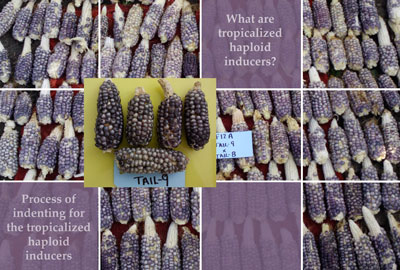 The doubled haploid (DH) technology enables rapid development of completely homozygous maize lines and offers significant opportunities for fast-track development and release of elite cultivars. Besides simplified logistics and reduced costs, use of DH lines in conjunction with molecular markers significantly improves genetic gains and breeding efficiency. DH lines also are valuable tools in marker-trait association studies, molecular marker-assisted or genomic selection-based breeding, and functional genomics.
The doubled haploid (DH) technology enables rapid development of completely homozygous maize lines and offers significant opportunities for fast-track development and release of elite cultivars. Besides simplified logistics and reduced costs, use of DH lines in conjunction with molecular markers significantly improves genetic gains and breeding efficiency. DH lines also are valuable tools in marker-trait association studies, molecular marker-assisted or genomic selection-based breeding, and functional genomics.
Generating DH lines involves four major steps: (1) In vivohaploid induction; (2) haploid seed identification using morphological markers; (3) chromosome doubling of putative haploids; and (4) generating D1 (DH) seed from D0 seedlings. In vivo haploid induction is achieved by crossing a specially developed maize genetic stock called an “inducer” (as male) with a source population (as female) from which homozygous DH lines are developed.
What are tropicalized haploid inducers?
Adoption of DH technology by public maize breeding programs and small- and mediumscale enterprise (SME) seed companies, especially in developing countries, is limited by the lack of inducers adapted to the tropical/subtropical conditions. The CIMMYT Global Maize Program, in collaboration with the Institute of Plant Breeding, Seed Science and Population Genetics of the University of Hohenheim (UHo) now has tropical haploid inducers for sharing with the interested institutions under the terms outlined below.
The tropically adapted inducer lines (TAILs) developed by CIMMYT and UHo showed high haploid induction capacity (~8-10%) and better agronomic performance than temperate inducers, in trials at two CIMMYT experiment stations in Mexico. A haploid inducer hybrid developed using these TAILs revealed heterosis for plant vigor and pollen production under tropical conditions, while maintaining similar haploid induction rates (~8-10%). CIMMYT and UHo decided to share the seed and grant authorization for use of one of the tropicalized haploid inducer lines (one of the parents of a hybrid inducer) and the hybrid inducer to interested applicants, after signing of the relevant material transfer agreement (MTA) and with restrictions to protect the intellectual property rights of both institutions for the inducer lines.
Process of indenting for the tropicalized haploid inducers
Interested applicants should send a letter of intent or an expression of interest in the tropicalized haploid inducers. CIMMYT may seek more information, if required, and will share the relevant MTA template for signing by applicants. The general guidelines to obtain inducers for research use and commercial use are as follows.
For research use by publicly-funded national agricultural research systems
Publicly-funded institutions interested in access to the haploid inducers for specific purposes (e.g., to develop DH lines for breeding programs) may send a letter of intent or expression of interest to CIMMYT. For eligible institutions, the haploid inducers will be provided free-of-charge by CIMMYT and UHo, after signing of a Research Use MTA. Commercial use of the inducers by institutions or others should be in accordance with a separate license agreement for commercial use (as given below).
For commercial use
Applicants may access the inducers for commercial use pursuant to signing of a Material Transfer and License Agreement with CIMMYT and UHo. Applicants shall pay UHo a one-time licence fee of USD 25,000 for provision of seed of two haploid inducers; these include one of the parents of a tropicalized haploid inducer hybrid and the haploid inducer hybrid itself. If applicants wish to access the other parent of the haploid inducer hybrid, an additional one-time licence fee of $10,000 will be payable to UHo.
Acknowledgments
Generous support for joint research on doubled haploids by CIMMYT and the University of Hohenheim has come from the Bill & Melinda Gates Foundation; the Howard G. Buffett Foundation; SAGARPA, the Mexican Ministry of Agriculture, Livestock, Rural Development, Fisheries and Food.; USAID (US Agency for International Development); Dr. Dr. h. c. Herrmann Eiselen and the Foundation fiat panis, Ulm, Germany; the Tiberius Services AG, Stuttgart, Germany; Vilmorin Seed Company; DTMA (Drought Tolerant Maize for Africa) project.;MAIZE CGIAR Research Program; and the International Maize Improvement Consortium (IMIC) project under MasAgro (Sustainable Modernization of Traditional Agriculture).
For further details, please contact:
Dr. BM Prasanna, Director, Global Maize Program, CIMMYT ( b.m.prasanna@cgiar.org), or
Dr. Vijay Chaikam, DH Specialist, Global Maize Program, CIMMYT ( v.chaikam@cgiar.org)
Maize Doubled Haploid Facility for Africa (3.17 MB)
The doubled haploid (DH) technology enables rapid development of completely homozygous maize lines and offers significant opportunities for fast-track development and release of elite cultivars. Besides simplified logistics and reduced costs, use of DH lines in conjunction with molecular markers significantly improves genetic gains and breeding efficiency. DH lines also are valuable tools in marker-trait association studies, molecular marker-assisted or genomic selection-based breeding, and functional genomics.
Generating DH lines involves four major steps: (1) In vivohaploid induction; (2) haploid seed identification using morphological markers; (3) chromosome doubling of putative haploids; and (4) generating D1 (DH) seed from D0 seedlings. In vivo haploid induction is achieved by crossing a specially developed maize genetic stock called an “inducer” (as male) with a source population (as female) from which homozygous DH lines are developed.
What are tropicalized haploid inducers?
Adoption of DH technology by public maize breeding programs and small- and mediumscale enterprise (SME) seed companies, especially in developing countries, is limited by the lack of inducers adapted to the tropical/subtropical conditions. The CIMMYT Global Maize Program, in collaboration with the Institute of Plant Breeding, Seed Science and Population Genetics of the University of Hohenheim (UHo) now has tropical haploid inducers for sharing with the interested institutions under the terms outlined below.
The tropically adapted inducer lines (TAILs) developed by CIMMYT and UHo showed high haploid induction capacity (~8-10%) and better agronomic performance than temperate inducers, in trials at two CIMMYT experiment stations in Mexico. A haploid inducer hybrid developed using these TAILs revealed heterosis for plant vigor and pollen production under tropical conditions, while maintaining similar haploid induction rates (~8-10%). CIMMYT and UHo decided to share the seed and grant authorization for use of one of the tropicalized haploid inducer lines (one of the parents of a hybrid inducer) and the hybrid inducer to interested applicants, after signing of the relevant material transfer agreement (MTA) and with restrictions to protect the intellectual property rights of both institutions for the inducer lines.
Process of indenting for the tropicalized haploid inducers
Interested applicants should send a letter of intent or an expression of interest in the tropicalized haploid inducers. CIMMYT may seek more information, if required, and will share the relevant MTA template for signing by applicants. The general guidelines to obtain inducers for research use and commercial use are as follows.
For research use by publicly-funded national agricultural research systems
Publicly-funded institutions interested in access to the haploid inducers for specific purposes (e.g., to develop DH lines for breeding programs) may send a letter of intent or expression of interest to CIMMYT. For eligible institutions, the haploid inducers will be provided free-of-charge by CIMMYT and UHo, after signing of a Research Use MTA. Commercial use of the inducers by institutions or others should be in accordance with a separate license agreement for commercial use (as given below).
For commercial use
Applicants may access the inducers for commercial use pursuant to signing of a Material Transfer and License Agreement with CIMMYT and UHo. Applicants shall pay UHo a one-time licence fee of USD 25,000 for provision of seed of two haploid inducers; these include one of the parents of a tropicalized haploid inducer hybrid and the haploid inducer hybrid itself. If applicants wish to access the other parent of the haploid inducer hybrid, an additional one-time licence fee of $10,000 will be payable to UHo.
Acknowledgments
Generous support for joint research on doubled haploids by CIMMYT and the University of Hohenheim has come from the Bill & Melinda Gates Foundation; the Howard G. Buffett Foundation; SAGARPA, the Mexican Ministry of Agriculture, Livestock, Rural Development, Fisheries and Food.; USAID (US Agency for International Development); Dr. Dr. h. c. Herrmann Eiselen and the Foundation fiat panis, Ulm, Germany; the Tiberius Services AG, Stuttgart, Germany; Vilmorin Seed Company; DTMA (Drought Tolerant Maize for Africa) project.;MAIZE CGIAR Research Program; and the International Maize Improvement Consortium (IMIC) project under MasAgro (Sustainable Modernization of Traditional Agriculture).
For further details, please contact:
Dr. BM Prasanna, Director, Global Maize Program, CIMMYT ( b.m.prasanna@cgiar.org), or
Dr. Vijay Chaikam, DH Specialist, Global Maize Program, CIMMYT ( v.chaikam@cgiar.org)
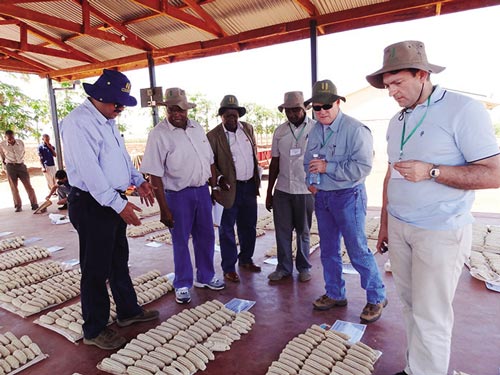 “One of the important ways to increase genetic gains and accelerate the development and deployment of improved varieties is to reduce the time needed for inbred development,” said B.M. Prasanna, CIMMYT’s Global Maize Program director. “The technology would also allow breeders to couple molecular marker-based selection for important traits such as disease resistance and quality at an early generation.” A project planning and review meeting held in Nairobi during 18-19 February 2013 was attended by representatives from national agriculture research systems, Kenya Seed Company, Seed Trade Association of Kenya, University of Hohenheim, the International Institute of Tropical Agriculture (IITA), and CIMMYT. “This technology will help us significantly improve maize food security in sub-Saharan Africa,” said Joseph Ochieng, KARI deputy director (food crops and crop protection), who spoke on behalf of the institute’s director Ephraim Mukisira. The KARI official emphasized the importance of educating stakeholders on this novel technology to ensure they understand its benefits and use the DH lines efficiently in breeding programs.
“One of the important ways to increase genetic gains and accelerate the development and deployment of improved varieties is to reduce the time needed for inbred development,” said B.M. Prasanna, CIMMYT’s Global Maize Program director. “The technology would also allow breeders to couple molecular marker-based selection for important traits such as disease resistance and quality at an early generation.” A project planning and review meeting held in Nairobi during 18-19 February 2013 was attended by representatives from national agriculture research systems, Kenya Seed Company, Seed Trade Association of Kenya, University of Hohenheim, the International Institute of Tropical Agriculture (IITA), and CIMMYT. “This technology will help us significantly improve maize food security in sub-Saharan Africa,” said Joseph Ochieng, KARI deputy director (food crops and crop protection), who spoke on behalf of the institute’s director Ephraim Mukisira. The KARI official emphasized the importance of educating stakeholders on this novel technology to ensure they understand its benefits and use the DH lines efficiently in breeding programs.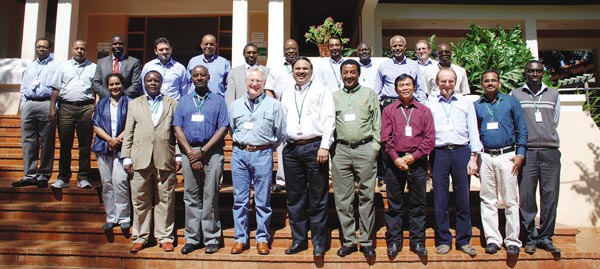
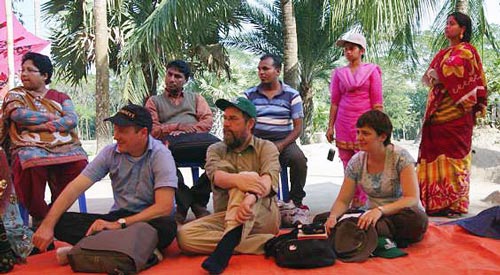
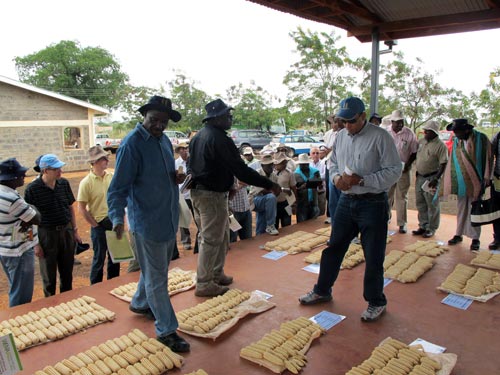 During 4-8 February 2013, stakeholders of the Water Efficient Maize for Africa (
During 4-8 February 2013, stakeholders of the Water Efficient Maize for Africa (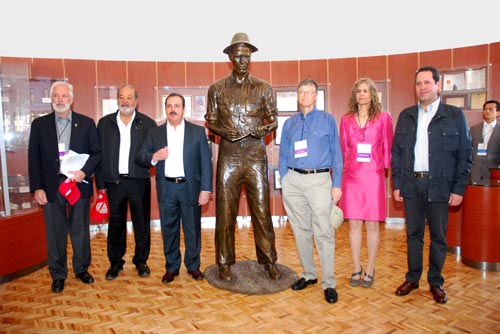 On 13 February 2013, CIMMYT inaugurated a new US$ 25 million research complex at its headquarters in El Batán. The new advanced bioscience research facilities, 45 kilometers (20 miles) from Mexico City, marked its grand opening to a crowd of more than 100 invited guests.
On 13 February 2013, CIMMYT inaugurated a new US$ 25 million research complex at its headquarters in El Batán. The new advanced bioscience research facilities, 45 kilometers (20 miles) from Mexico City, marked its grand opening to a crowd of more than 100 invited guests.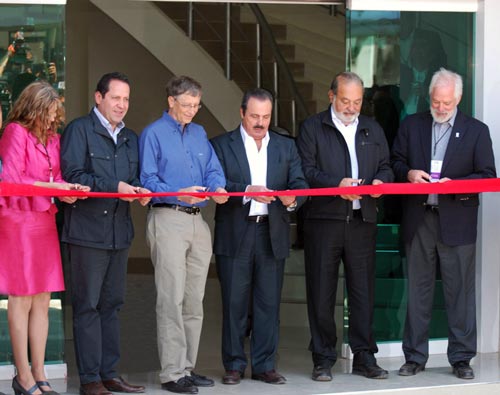
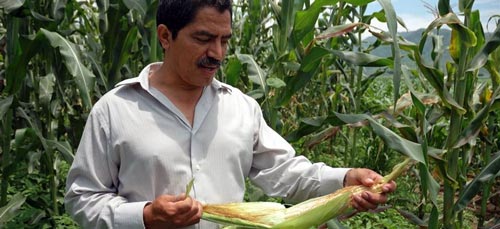
 The doubled haploid (DH) technology enables rapid development of completely homozygous maize lines and offers significant opportunities for fast-track development and release of elite cultivars. Besides simplified logistics and reduced costs, use of DH lines in conjunction with molecular markers significantly improves genetic gains and breeding efficiency. DH lines also are valuable tools in marker-trait association studies, molecular marker-assisted or genomic selection-based breeding, and functional genomics.
The doubled haploid (DH) technology enables rapid development of completely homozygous maize lines and offers significant opportunities for fast-track development and release of elite cultivars. Besides simplified logistics and reduced costs, use of DH lines in conjunction with molecular markers significantly improves genetic gains and breeding efficiency. DH lines also are valuable tools in marker-trait association studies, molecular marker-assisted or genomic selection-based breeding, and functional genomics.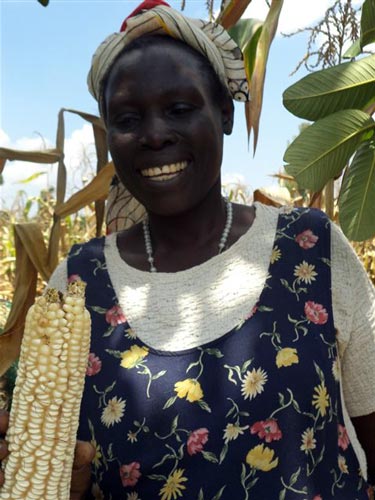 “Women are a key part of the mainstream in agriculture, yet they face formidable obstacles,” said CIMMYT gender and development specialist Vongai Kandiwa during a recent seminar in Nairobi, Kenya. Vongai was speaking on the importance of having a strategy to put men and women’s concerns and experiences at the centre of research design, implementation, monitoring, and evaluation. This involves looking at the socioeconomic settings of men and women to ensure that they benefit equally – often referred to as “gender mainstreaming.” The seminar was attended by colleagues working on various aspects of maize technology development, production, and dissemination. “By closing the gap in access to technology between men and women, we could increase productivity by 30%,” said Vongai, referring to the
“Women are a key part of the mainstream in agriculture, yet they face formidable obstacles,” said CIMMYT gender and development specialist Vongai Kandiwa during a recent seminar in Nairobi, Kenya. Vongai was speaking on the importance of having a strategy to put men and women’s concerns and experiences at the centre of research design, implementation, monitoring, and evaluation. This involves looking at the socioeconomic settings of men and women to ensure that they benefit equally – often referred to as “gender mainstreaming.” The seminar was attended by colleagues working on various aspects of maize technology development, production, and dissemination. “By closing the gap in access to technology between men and women, we could increase productivity by 30%,” said Vongai, referring to the 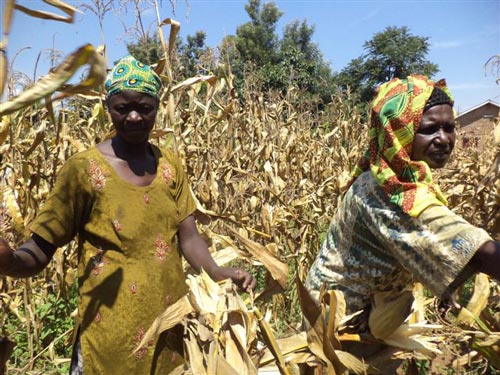 Paying particular attention to research innovations that would reduce the drudgery of farm work for women is also important, highlighted the global maize program director B.M. Prasanna. Prasanna pointed to quality protein maize (QPM) as a product developed with the nutrition needs of end users—and particularly women— in mind. QPM has increased amounts of lysine and tryptophan, important amino acids which improve nutrition. Prasanna also pointed out the promise of pesticide resistant maize that would reduce the burden of weeding for women who often provide most of the farm labor.
Paying particular attention to research innovations that would reduce the drudgery of farm work for women is also important, highlighted the global maize program director B.M. Prasanna. Prasanna pointed to quality protein maize (QPM) as a product developed with the nutrition needs of end users—and particularly women— in mind. QPM has increased amounts of lysine and tryptophan, important amino acids which improve nutrition. Prasanna also pointed out the promise of pesticide resistant maize that would reduce the burden of weeding for women who often provide most of the farm labor.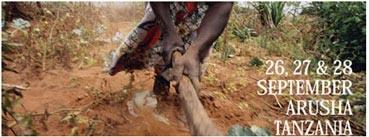 “We have arrived at the tipping point and are not taking Africa’s Green Revolution to scale,” said Kofi Annan during the opening session of the 2012 African Green Revolution Forum which took place in Arusha, Tanzania, from 26-28 September. The forum gathered 1,000 participants from ministries of agriculture, industry, and the international donor community. CIMMYT was represented by Wilfred Mwangi. Melinda Gates of the Bill & Melinda Gates Foundation (
“We have arrived at the tipping point and are not taking Africa’s Green Revolution to scale,” said Kofi Annan during the opening session of the 2012 African Green Revolution Forum which took place in Arusha, Tanzania, from 26-28 September. The forum gathered 1,000 participants from ministries of agriculture, industry, and the international donor community. CIMMYT was represented by Wilfred Mwangi. Melinda Gates of the Bill & Melinda Gates Foundation (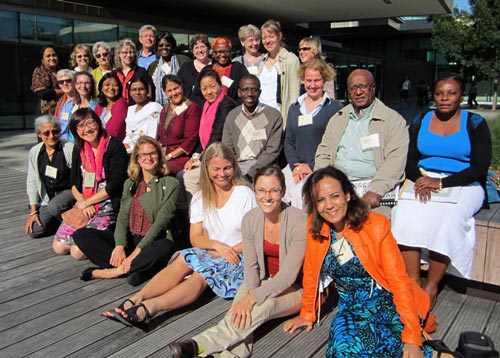 “The workshop was a great opportunity to share ideas and lessons learned, to exchange concepts of different gender strategies, as well as to discuss the latest gender-related research methods,” said Beuchelt. The workshop identified four themes for cross-program research on gender and agriculture: (1) engendering agricultural value chains; (2) gender-transformative approaches; (3) gender and technology adoption and diffusion; and (4) gender and nutrition. The participants also agreed upon a shared set of gender-responsive research outcomes that can be jointly monitored to assess progress towards CGIAR System Level Outcomes. Furthermore, they discussed how to measure these outcomes and agreed to continue collaboration on the development and measurement of a shared set of genderresponsive indicators.
“The workshop was a great opportunity to share ideas and lessons learned, to exchange concepts of different gender strategies, as well as to discuss the latest gender-related research methods,” said Beuchelt. The workshop identified four themes for cross-program research on gender and agriculture: (1) engendering agricultural value chains; (2) gender-transformative approaches; (3) gender and technology adoption and diffusion; and (4) gender and nutrition. The participants also agreed upon a shared set of gender-responsive research outcomes that can be jointly monitored to assess progress towards CGIAR System Level Outcomes. Furthermore, they discussed how to measure these outcomes and agreed to continue collaboration on the development and measurement of a shared set of genderresponsive indicators.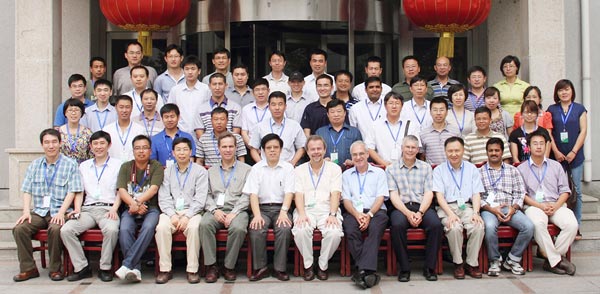
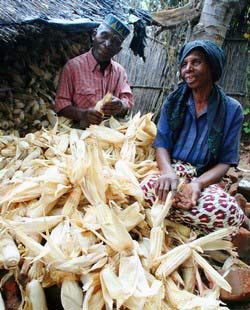 “The climate is changing, rainfall is decreasing and the weather is now dictating which varieties farmers grow and in turn which varieties seed companies produce,” says Dellings Phiri, general manager of Seed Co. Malawi, a leading southern African seed company.
“The climate is changing, rainfall is decreasing and the weather is now dictating which varieties farmers grow and in turn which varieties seed companies produce,” says Dellings Phiri, general manager of Seed Co. Malawi, a leading southern African seed company.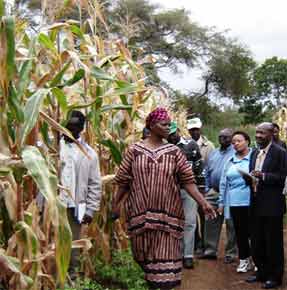 CIMMYT’s partnerships on maize in eastern Africa hark back to the 1960s, when the center was launched. Formal networking since that time with researchers and extension workers, policy makers, non-government organizations, seed companies, millers, and farmers have culminated in successful breeding and dissemination teams and promising new varieties rated highly by farmers. Awards to teams in Tanzania and Ethiopia recently highlighted the value of these partnerships.
CIMMYT’s partnerships on maize in eastern Africa hark back to the 1960s, when the center was launched. Formal networking since that time with researchers and extension workers, policy makers, non-government organizations, seed companies, millers, and farmers have culminated in successful breeding and dissemination teams and promising new varieties rated highly by farmers. Awards to teams in Tanzania and Ethiopia recently highlighted the value of these partnerships.